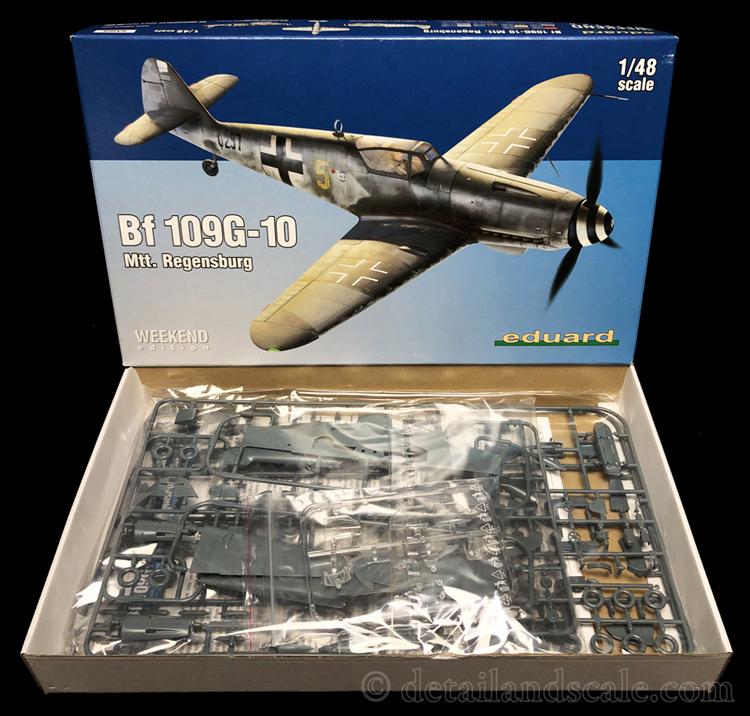Eduard Bf 109G-10 Mtt. Regensburg Weekend Edition — 1:48 Scale


The Messerschmitt Bf 109 is one of the most storied warplanes of the 20th century and one of the most popular subjects for scale model kits. It has been the subject of hundreds injection-molded kits along with more esoteric limited-run resin and vacuform offerings in just about every imaginable scale. In this review, we sit down with Eduard’s recent release of a very straightforward Weekend Edition of their 1:48 scale Bf 109G-10 Mtt. Regensburg kit.

The Bf 109 needs little introduction as one of the two premier single-seat German fighters of the Second World War. The prototype flew in 1935 and marked the start of a production run of 33,984 airframes spanning dozens of variants and subtypes. It was a highly advanced fighter for the mid-1930s, featuring all-metal monocoque construction, a closed canopy, and retractable landing gear. As a testament to the versatility of the design, Bf 109s were still deadly opponents ten years later. While many contemporaries came and went, the Bf 109 was still in the fight as the war came to a close and the jet era was dawning.
The Bf 109G, also known as the Gustav, was an evolutionary development of the Bf 109F-series. Externally, 109Gs started off being nearly identical to their predecessor. Internally, the wings were reinforced, the windscreen was bulletproofed, and the fuel tanks surrounded by light armor. Other changes included outer wheel bay shape changes and the addition of air inlet scoops on both sides of the forward engine cowling that held the new Daimler-Benz DB 605A engine. The initial variants (G-1 through G-4) differed only in minor ways from the Bf 109F, most notably in the more powerful DB 605 engine.
The G-10 came into being in December 1944. The G-10 was a standard new build Bf 109G airframe paired with the DB 605 D-2 engine which was destined for the Bf 109K. Yet, these powerplants were ready before the airframes and would fit G-10s rolling off the assembly line. Thus, fitting available DB 605 D-2s into a G-model would be the least disruptive and most efficient thing to do until the K-model assembly line was ready. Also, some G-10s had G-14 data plates, but those were G-14 airframes that had been reallocated to G-10 assembly lines. Some 2,600 G-10s were produced between the Erla, WNF, and Messerschmitt (Mtt) Regensburg factories. Each production line produced the Bf 109G-10 a little differently, and each factory ultimately manufactured a G-10 with their own little configurational quirks.

Eduard’s Bf 109G-10 Mtt. Regensburg Weekend Edition in 1:48 scale is a 2020 re-boxing issue of their original 2018 new-tool ProfiPACK release. This Weekend Edition features 188 parts on four blue-gray sprues, and 10 clear parts on one clear sprue. About 70 parts in the kit are not used in the construction of the Regensburg G-10. The instructions guide the build over nine pages. The markings come on two Eduard-printed decal sheets for the following airplanes:
- Bf 109G-10 W.Nr.130297, flown by Fw. Horst Petzschler, 10./JG 51, Bulltofta, Sweden, May 1945
- Bf 109G-10 W.Nr.130368, NJG 11, Fassberg, Germany, March 1945
Strengths: As is the case with all of Eduard’s 1:48 scale Bf 109s, including the retooled Eduard Bf 109Gs that came on the scene in 2016, this kit is excellent by any standard. This kit is part of a trilogy of 1:48 scale Bf 109G-10 kits produced by Eduard, each one retooled ever so slightly to accurately represent each sub-variant of the G-10. Eduard has really done a great job capturing these subtleties. The only difference with the earlier releases is that as a Weekend Edition offering, there are no detail parts and only two markings options are included.
This kit is known to go together quite well. Instrument panel details can be painted or represented by decals, and as the Weekend Edition of the kit, the seat’s shoulder harnesses and lap belts are only provided as decals. Exterior surface details including the recessed panel lines, rivets, and fasteners are all simply sublime. It has a range of construction options, including the positionable canopy, leading edge slats, flaps, ailerons, elevator, rudder, and radiator flaps. You can position the flaps as desired. While the instructions show the separate elevators going straight-in, you can easily modify them if you want them dropped. There’s an even larger mounting pin for the rudder, so to deflect the rudder (if that is what you are going for) just a tiny bit of work hacking off that mounting pin will get the job done.
The decals are printed by Eduard and look technically excellent, with great color, resolution, and thin restrained carrier film. The second, smaller sheet contains a complete set of maintenance stencils for a single G-10. The markings options are both great choices, but the late war colors and lack of camouflage of the second option is intriguing and certainly unusual.
Weaknesses: Eduard’s 1:48 scale Bf 109G-10 is hard to fault. Still, the injection-molded instrument panel is a little basic for some, and you really do need to use the kit-supplied instrument panel decal to represent any instrument face details. While seatbelts and harnesses are provided, they are also in decal form (not your reviewer’s favorite choice for belts).

The Eduard 1:48 scale Bf 109G-10 Weekend Edition is a streamlined, no-frills boxing of this kit. If that’s what you’re looking for, you simply can’t go wrong. Still, if you find yourself looking for more detail, Eduard produces an entire range of photoetched metal and Brassin sets for their 1:48 Gustav, from seatbelts to landing flaps and just about everything else in between.
Sincere thanks are owed to Eduard for the review sample. You can visit them on the web at http://www.eduard.com and on Facebook at https://www.facebook.com/EduardCompany
Haagen Klaus
Scale Modeling News & Reviews Editor
Detail & Scale






